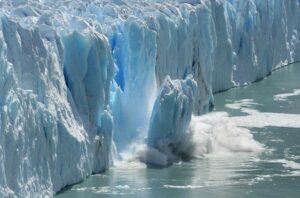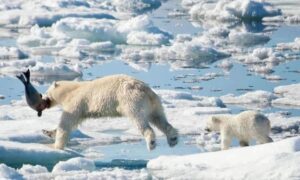The world’s largest iceberg with a huge area of 4,000 square kilometers, nearly 3 times the size of New York City, has separated from Antarctica and moved toward the area where the Titanic tragedy occurred.
The iceberg is heading towards the area where the Titanic tragedy occurred
Scientists say the iceberg, named A23a, is the largest iceberg in the world with a huge area of 1,500 square miles (4,000 km2, nearly 3 times the area of New York City) that has separated from the ocean floor. positive.
Previously, this iceberg separated from the Antarctic coast in 1986, but quickly “parked” in the Weddell Sea, turning this area into an ice island.
After 37 years, scientists confirmed on November 24 that satellite images showed that the trillion-ton mass of ice had drifted north across the Antarctic Peninsula, aided by strong winds and currents. Ocean.
An iceberg of this size moving is a rare sight for glaciologists. “Over time it probably just thinned a little and gained a little more buoyancy allowing it to rise off the ocean floor and be pushed along by ocean currents,” said Oliver Marsh of the British Antarctic Survey. said, according to Reuters.
Like most icebergs in the region, A23a will most likely move into the Antarctic Current, which will take it to “Iceberg Alley”, where several icebergs congregate in dark waters , such as the waters where the Titanic collided with an iceberg in 1912, causing the ship to sink and 1,517 people died.
Scientists are also concerned that the giant iceberg could again fall on South Georgia Island in the South Atlantic, potentially devastating Antarctic wildlife by cutting off access to of millions of seals, penguins and seabirds that use this area to breed or hunt and forage.
Marsh told Reuters: “An iceberg of this size is likely to persist for quite some time in the Southern Ocean, even though the weather is much warmer… It could move further north.” to South Africa, and causing disruption to shipping operations there.”

There is a risk that half of the glaciers will disappear by 2100
Researchers estimate that 49% of the world’s glaciers will disappear by 2100, accounting for about 26% of the world’s glacier mass. This is the result of a study published in Science magazine in early 2023.
The researchers looked at the impact of four scenarios on glaciers, which were based on global average temperature changes of 1.5 degrees Celsius, 2 degrees Celsius, 3 degrees Celsius and 4 degrees Celsius.
Even with the most ambitious target in the 2015 Paris Agreement on climate change limiting global warming to 1.5 degrees Celsius above pre-industrial levels, 49% of the world’s glaciers will also disappear by 2100.
According to Regine Hock of Osla University and the University of Alaska Fairnk, co-author of the study, areas with relatively little ice, such as the European Alps, the Caucasus, the Andes or the American West, lost almost all of their ice. ice set by the end of the century, regardless of the emissions scenario.
In the worst scenario of a global temperature increase of 4 degrees Celsius, giant glaciers like those in Alaska will be more affected and 83% of glaciers will disappear by the end of this century.
Meanwhile, according to a report by the United Nations Educational, Scientific and Cultural Organization (UNESCO) published in November 2022, some of the world’s most famous glaciers such as those on the Dolomites ( Italy), in Yosemite and Yellowstone national parks (USA) and in the Kilimanjaro mountain range (Tanzania) will disappear by 2050 due to global warming.
UNESCO monitors some 18,600 glaciers at the 50 World Heritage sites it recognizes and predicts that about 33% of them will disappear by 2050.
The remaining glaciers can be saved if global temperature increases do not exceed 1.5 degrees Celsius compared to pre-industrial times.

What tragedy could happen if the glacier melts?
Melting ice is a phenomenon in which blocks of ice separate into small pieces that float and then sink to the ocean surface. This process causes the world’s glaciers to become increasingly unstable and sea levels to rise. This phenomenon has led to a number of consequences that affect human life and the Earth.
Severe Climate Change
As the earth’s average temperature increases, the ice at the poles will melt. Along with that, the permanent CO2 ice layer is exposed and participates in the circulatory activities of all living organisms on earth. A large increase in the amount of CO2 in the atmosphere will cause a greenhouse effect, depleting the Ozone layer. There will be less green trees due to CO2 overload, causing the earth to warm up.
Rising temperatures also worsen air pollution from the ozone layer. In particular, emissions from vehicles, factories, and other sources react with sunlight and heat, etc. The ground-level ozone layer is the main contributor to photochemical smog. And the higher the temperature, the thicker the fog. Air pollution leads to increased hospitalization and death rates in asthma patients. worsen the condition of people with heart or lung disease.
The heat lasts for a long time
Prolonged heat waves dry out the land, all rivers and lakes will evaporate, and cause widespread drought, desert-like climate, and uncontrolled forest fires.
In many parts of the world, water shortages lead to serious diseases. On the contrary, heavy rain causes rivers and lakes to overflow their banks, destroying houses. Pollution of drinking water sources, waste dispersion and air pollution. At the same time, hot and humid conditions also create conditions for water- and food-borne diseases to develop.
Sea level rising
Melting ice will cause sea levels to rise by 66 m. With this situation, coastal cities such as Shanghai (China), New York (USA) and London (UK) will be submerged by this huge flood. This will cause 40% of the world’s population to lose their homes and cause much chaos on the ground.
As a result, rising sea levels will penetrate underground water reserves located deep inland, and reach nearby freshwater aquifers. Notably, the freshwater aquifer is the source of drinking water, irrigation water and water used for power plant cooling systems. But as glaciers around the globe melt, all aquifers will be destroyed.
Impact on ships traveling at sea
Melting ice will create large icebergs that drift in the sea. This affects the movement of ships. When ships moving at sea collide with large icebergs, the ship will be severely damaged and may even be submerged.

Effects on animals
Melting ice increases the earth’s average temperature, changing the habitat of many animals, leading to the disappearance or risk of extinction of species. Due to habitat loss due to fallow land, deforestation and warming sea levels, about 50% of plant and animal species will be threatened with extinction by 2050 if global temperatures increase by 1.1 to 6.0 degrees, 4 degrees Celsius. For example, red foxes used to live in North America, but have now moved to the Arctic. Polar bears are also a typical species. If the amount of ice melts at a rapid rate like today, this species of bear will have difficulty finding food. Similar to polar bears, Antarctic penguins also suffer the same fate. As the ice surface decreases, it means losing habitat and food sources.
Disease is widespread
The melting of Earth’s glaciers will “awaken” ancient viruses that have been frozen for a long time. This will be a terrifying threat to humanity. Previously, in 2015, scientists discovered the accumulation of ancient viruses thousands of years old in permafrost in Siberia. These ancient viruses are like a sealed Pandora’s box. However, the melting of Earth’s glaciers is the key to opening this box.
Earthquakes and volcanoes
With the sudden increase in sea level due to the simultaneous melting of glaciers, the Earth’s rotation speed will gradually slow down. The energy accumulated in the Earth’s crust will be released, and violent earthquakes will frequently occur around the world. At the same time, active volcanoes will also erupt immediately.

